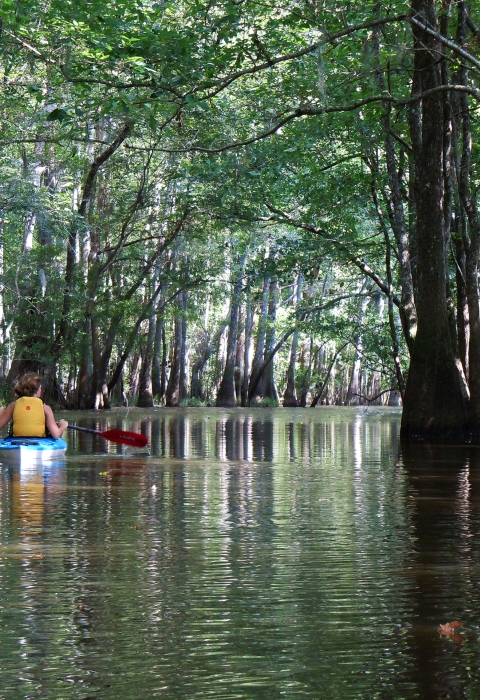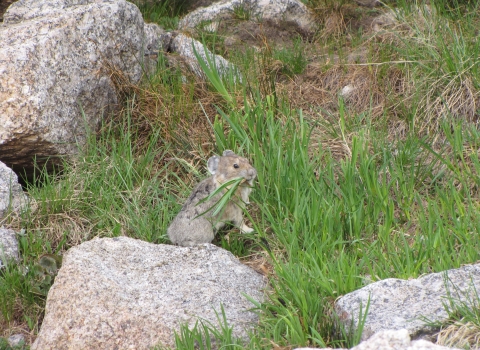The Waccamaw National Wildlife Refuge announced today the expansion of Hasty Point Plantation, a unique historical and cultural destination within the National Wildlife Refuge system.
The 237-acre “Triangle Tract” which is now part of the Waccamaw National Wildlife Complex was originally acquired in 2021 by the Open Space Institute (OSI), thanks to the generosity of the property’s former owner Robert (Bob) Schofield.
This land transfer to Waccamaw National Wildlife Refuge enhances opportunities for public access, environmental education, and historical interpretation of this former working rice plantation. (See map and photos here.)
“The Triangle Tract will play a key role in allowing the refuge to open Hasty Point to the public in the coming months,” said Craig Sasser, manager of the Waccamaw National Wildlife Refuge. “It was purchased with Recreational Access Funds, a highly competitive federal funding source that is structured to improving access to public lands. This acquisition will also be a very important addition for our youth hunting program. It wouldn't have been possible without key partnerships, including Bob Schofield and the Open Space Institute.”
The Triangle Tract property — adjacent to Hasty Point Plantation on a high bluff at the confluence of the Pee Dee River and Thoroughfare Creek — is within the scenic viewshed of the Plantersville Scenic Byway and the State Scenic River-designated portion of the Great Pee Dee River. This acquisition by the U.S. Fish and Wildlife Service advances a community-based planning initiative and a master plan at the Waccamaw National Wildlife Refuge that includes educational interpretation of the history of enslaved people at Hasty Point Plantation and within the larger Plantersville Historic District.
“The protection of the Triangle Tract is incredibly important for preserving Hasty Point Plantation as a critical link to South Carolinians’ past and ensuring that future generations can better grasp the painful sacrifices of the plantation’s enslaved workers,” said Maria Whitehead, OSI Senior Project Manager. “The Open Space Institute is honored and humbled to contribute the Triangle Tract to Waccamaw National Wildlife Refuge, and we thank the U.S. Fish & Wildlife Service for their dedication to South Carolina.”
OSI purchased the Triangle Tract through the willingness and generosity of the former owner who sold the property at a discount to make the purchase possible.
“I felt it would be lovely to open the place to the local descendants of those who had worked on it, and after the Waccamaw National Wildlife Refuge manager said the Triangle Tract would greatly augment the acquisition of Hasty Point, I wondered how to finalize the project,” said Schofield. “When I learned it was possible with the help of the Open Space Institute, which has an amazing track record in South Carolina, it was magic.”
Located along the western border of the Waccamaw National Wildlife Refuge, the Triangle Tract is directly adjacent to the 773-acre Hasty Point Plantation and rice fields the refuge purchased in 2020 with assistance from OSI, Ducks Unlimited, and other partners.
With the protection of the two properties, totaling 1,010 acres, the Waccamaw National Wildlife Refuge embarked on the first phase of a master plan that included community input on public-use opportunities, including future programming and interpretation. As planned, once opened to the public, visitors will have access to a walking tour, history exhibits, and kiosks interpreting the history of Hasty Point. Waccamaw National Wildlife Refuge plans to open Hasty Point Plantation to the public this year, which marks the 25th anniversary of the founding of the refuge.
Together, both properties will be restored by Waccamaw National Wildlife Refuge to provide habitat for a host of rare and threatened species, including swallow-tailed kites, bobwhite quail, wild turkey, red-cockaded woodpeckers, wintering waterfowl, wood storks, and songbirds — all of which thrive on the land’s native longleaf pine forest, intact rice field impoundments, and freshwater forested wetlands.
In addition to their ecological significance, the properties are teeming with history. Located in the heart of the territory of the Waccamaw Indian People, Hasty Point Plantation was seized from British troops during a Revolutionary War raid.
Hasty Point Plantation, which includes a rare and historic standing rice barn and functional rice fields, is listed on the National Register of Historic Places for its place in South Carolina’s rice-growing history. The site is one of 25 rice plantations in Georgetown County’s Historic Plantersville District, the cornerstone of the Lowcountry’s tragic slave-based economy for 150 years. The region produced most of South Carolina’s rice when the colony, and later state, was a leader in rice production.
The Triangle Tract acquisition marks OSI’s third significant land contribution to Georgetown County since January and its second to Waccamaw National Wildlife Refuge. It joins other OSI projects intended to expand or augment Waccamaw National Wildlife Refuge. This year, OSI acquired the 56-acre Hendrix property and supported the acquisition by the Village Group of a long-sought-after 10-acre property that will serve as the future home of the Plantersville Cultural Complex.
Waccamaw National Wildlife Refuge was established on December 1, 1997, to protect and manage diverse habitat within coastal river ecosystems and to provide wildlife-dependent recreational activities such as hunting, fishing, wildlife observation, photography, and environmental education. The wetland diversity on the refuge provides important habitat for migratory birds, fish, and other wildlife.
Waccamaw National Wildlife Refuge consists of wetland habitats ranging from historic, broken and actively managed tidal rice fields, to blackwater and alluvial flood plain forested wetlands of the Waccamaw and Great Pee Dee Rivers. These tidal freshwater wetland ecosystems are some of the most diverse freshwater wetland systems in North America. They not only provide important habitats corridors for wildlife, but they also play a critical role in the filtration and storm water retention for the primary drinking water resource of the greater Grand Strand region.
The Open Space Institute protects scenic, natural, and historic landscapes to provide public enjoyment, conserve habitat and working lands, and sustain communities. OSI has been a partner in the protection of more than 2.3 million acres in North America, including more than 70,000 acres in the Southeast. Visit OSI online at openspaceinstitute.org/states/south-carolina.




